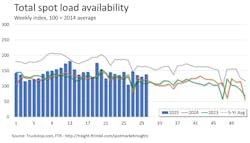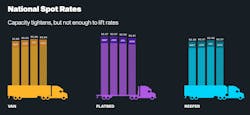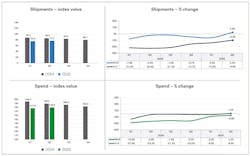Key takeaways
- Freight demand increased in July, but capacity shrank, leading to a slight uptick in spot rates for dry van and refrigerated equipment, while flatbed rates declined.
- Carrier optimism is waning, with fewer expecting rate increases and more expressing concerns about tariffs and industry health, especially among small fleets.
- Q2's freight gains were driven partly by tariff frontloading, industry analysts noted.
Though rates improved slightly for some, the overall for-hire freight environment is still less than hospitable to carriers.
According to analysis of spot and contract market data from DAT Freight & Analytics, FTR Transportation Intelligence, and U.S. Bank, freight growth remained modest while for-hire rates inched upward at a fraction of the freight growth rate. A recent Truckstop survey found that small fleets’ optimism is weakening.
“Despite the strong import figures in June, industry experts note a prevalent sentiment of caution and a more strategic approach among companies moving forward, largely attributed to the uncertain tariff environment,” DAT’s principal analyst Dean Croke said.
For July, freight demand grew while capacity shrank
Weekly data, according to Truckstop’s spot market for the week ending August 1, found an increase in spot rates for the first time in four weeks. That long-awaited rate increase, however, was only for dry van and refrigerated equipment—flatbed spot rates declined for the fourth consecutive week, though the decrease was marginal.
Analysis of Truckstop’s market by FTR Transportation Intelligence found a 5.9% increase in total load activity, while total truck postings fell by 5.2%, bringing the Market Demand Index to its highest level in three weeks. Total volume was 14% higher than the same week in 2024 but still 16% below the five-year average.
“The moves for all three equipment types were in line with seasonal expectations for the beginning of August as van rates tend to stabilize while flatbed rates continue to fade,” FTR’s analysis said.
Overall, the total market broker-posted spot rate ticked up by one cent. Rates were down 0.2% year over year and about 9% below the five-year average. Dry van spot rates increased by 1.7 cents, refrigerated rates increased by 2.1 cents, and flatbed rates declined by three-tenths of a cent.
Monthly data from DAT Freight & Analytics found similar trends for the spot market: Loads were up while truck posts were down. That pattern is good news for a market where overcapacity is the prime suspect for weak rates. Rates for the month overall, however, were either flat or down compared to the previous year.
Spot load posts according to DAT increased by 1.7% from June (and rose 19.9% year over year), while truck posts decreased 5.7% from June (and fell 30% from last year). Those shifts dramatically raised DAT’s measure of load-to-truck ratios for all three equipment types: Dry van’s ratio rose 11.7% month over month and 57.3% year-over-year; the refrigerated ratio increased 14.5% month over month and 84.3% year over year; flatbed ratios fell 4.9% month over month but increased a whopping 101.4% year over year.
See also: Not enough drivers or too many?
Much of the increase in volume in July, DAT’s Croke warned, was still due to tariff frontloading recorded from June, particularly for the dry van segment moving freight originating from West Coast ports.
U.S. Bank: Q2 saw best freight gains in years
U.S. Bank’s measure of freight, its National Shipments Index, rose 2.4% from Q1 this year to Q2. It was the index’s first sequential gain in three years and its largest in four years. Year over year, however, the index for Q2 was still down 9.8%.
The U.S. Bank National Spend Index, which broadly indicates freight rates across contract and for-hire fleets, including fuel surcharges, increased at half the rate of the Shipments Index, at 1.2%. Year over year, the Spend Index was still down 4.9%. U.S. Bank’s report attributed the slower rate of growth to, in part, major fuel surcharge declines throughout Q2.
“These year-over-year trends point to a market that is tighter compared with a year ago, as struggling fleets continue to exit the industry, or carriers cut capacity,” the report said
Survey: Small fleet optimism is weakening
Truckstop’s midyear survey conducted with Bloomberg Intelligence found that many fleets still expect rates to improve.
“Many carriers and brokers remained optimistic through the first half of 2025 despite facing difficulties,” said Todd Markusic, customer insights manager at Truckstop. “While the freight market underperformed in the second quarter, with no clear resolution for how tariffs will impact the economy, many in the industry are expecting a recovery in the next six months.”
The survey included responses from 204 carrier firms (most representative of small and flatbed fleets) and 185 brokerages.
On the bright side, 17% of carriers said rates have improved since Q2 2024, and 84% of carriers think rates will go up or stay flat over the next 6 months.
A rate improvement for 17% is less than many had hoped for: In Truckstop’s Q1 survey, 55% of carriers expected a spot rate increase in Q2.
Among brokers, 39% said spot rates were up from the first half of 2024, and 78% said contract rates were up. About 80% of brokers expect rates to remain stable or increase in the next six months.
Truckstop’s recent surveys, mostly representative of fleets with one to five vehicles, often saw optimistic responses despite a weak market. However, carriers’ optimistic outlooks were less pronounced this time around:
- The number of fleets expecting rates to rise in Q3 (42%) was down 13 points from Q1.
- Carriers that were unsure when rates would bottom out (48%) increased 7 points from Q1.
- Only 21% of carriers said they plan to purchase new equipment, down from 38% in Q1.
- About 38% of carriers believed tariffs would significantly hurt the industry, up from 30% last quarter.
- Carriers that say they are satisfied with their work fell from 65% in Q1 to 54% in Q2.
About the Author
Jeremy Wolfe
Editor
Editor Jeremy Wolfe joined the FleetOwner team in February 2024. He graduated from the University of Wisconsin-Stevens Point with majors in English and Philosophy. He previously served as Editor for Endeavor Business Media's Water Group publications.




